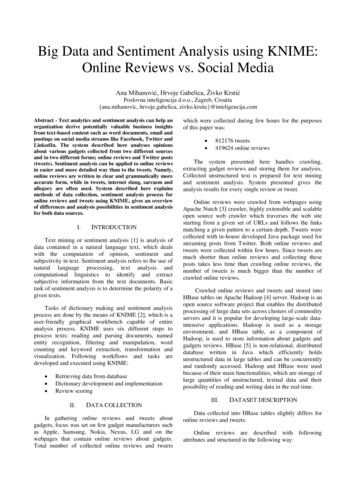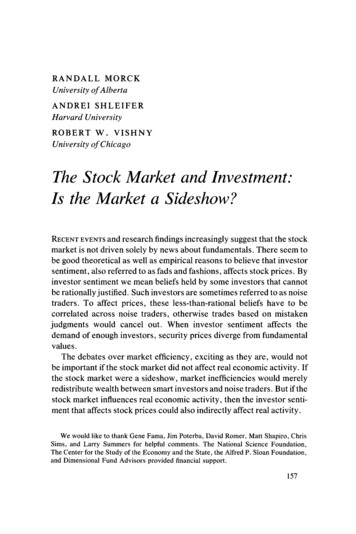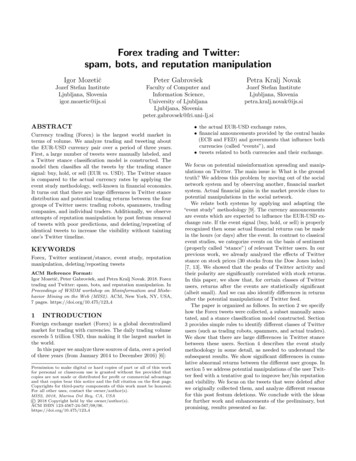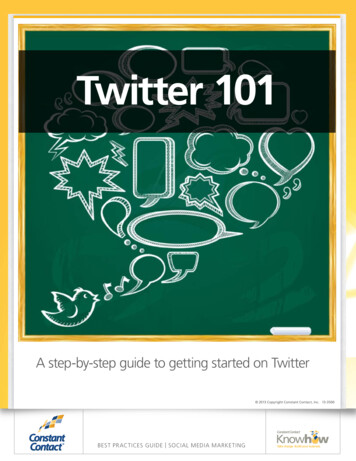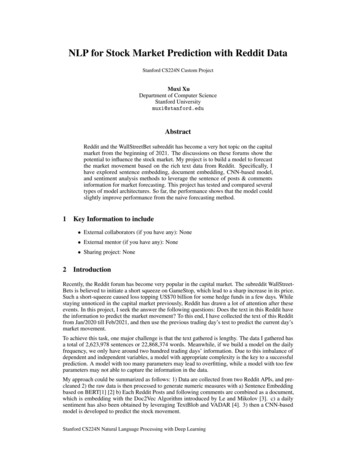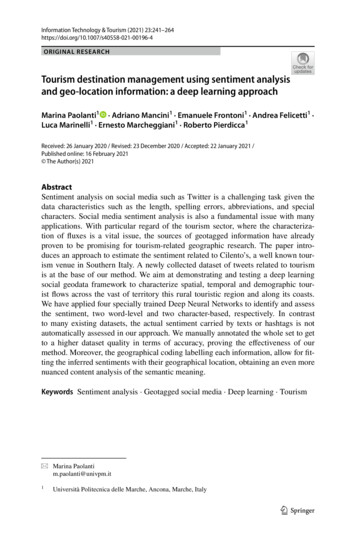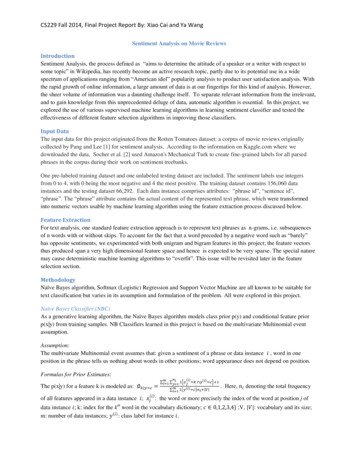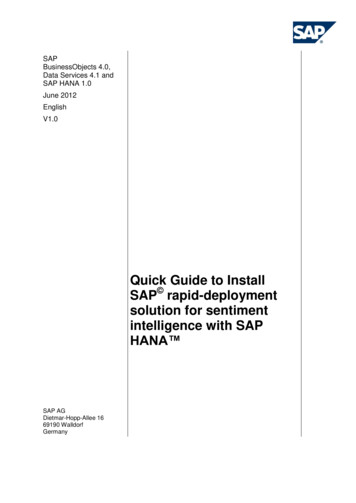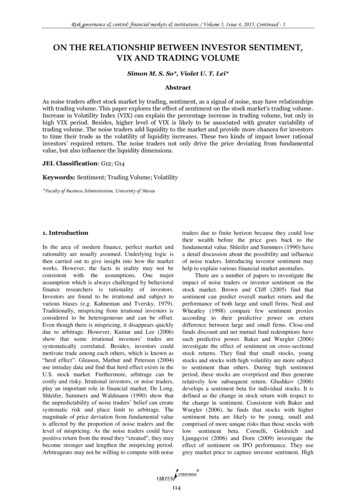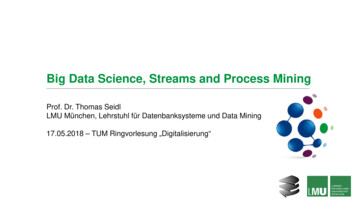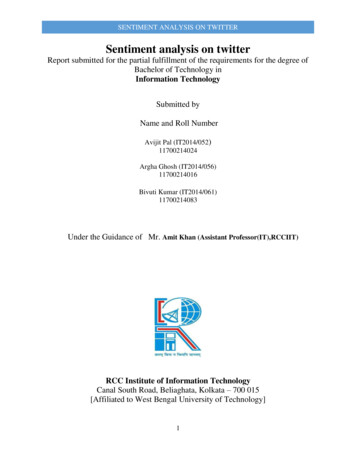
Transcription
SENTIMENT ANALYSIS ON TWITTERSentiment analysis on twitterReport submitted for the partial fulfillment of the requirements for the degree ofBachelor of Technology inInformation TechnologySubmitted byName and Roll NumberAvijit Pal (IT2014/052)11700214024Argha Ghosh (IT2014/056)11700214016Bivuti Kumar (IT2014/061)11700214083Under the Guidance of Mr. Amit Khan (Assistant Professor(IT),RCCIIT)RCC Institute of Information TechnologyCanal South Road, Beliaghata, Kolkata – 700 015[Affiliated to West Bengal University of Technology]1
SENTIMENT ANALYSIS ON TWITTERAcknowledgementWe would like to express our sincere gratitude to Mr. Amit khan of the department of InformationTechnology, whose role as project guide was invaluable for the project. We are extremely thankfulfor the keen interest he took in advising us, for the books and reference materials provided for themoral support extended to us.Last but not the least we convey our gratitude to all the teachers for providing us the technical skillthat will always remain as our asset and to all non-teaching staff for the gracious hospitality theyoffered us.Place: RCCIIT, KolkataDate: 14.05.2018Avijit PalArgha GhoshBivuti KumarDepartment of Information TechnologyRCCIIT, Beliaghata,Kolkata – 700 015,West Bengal, India2
SENTIMENT ANALYSIS ON TWITTERApprovalThis is to certify that the project report entitled “Sentiment analysis on twitter” prepared undermy supervision by Avijit Pal (IT2014/052), Argha Ghosh (IT2014/056), Bivuti Kumar(IT2014/061) ., be accepted in partial fulfillment for the degree of Bachelor of Technology inInformation Technology.It is to be understood that by this approval, the undersigned does not necessarily endorse or approveany statement made, opinion expressed or conclusion drawn thereof, but approves the report only. .Dr.Abhjit Das.HOD,ITRCC Institute of Information Technology Mr.Amit khanAssistant ProfessorRCC Institute of Information Technology3
SENTIMENT ANALYSIS ON TWITTERINDEX:ContentsPage Numbers1. Introduction52. Problem Definition73. Literature Survey84. SRS (Software RequirementSpecification)145. Design186.Results and Discussion287. Conclusion and Future Scope326.Reference334
SENTIMENT ANALYSIS ON TWITTERIntroduction:In the past few years, there has been a huge growth in the use of microblogging platforms such asTwitter. Spurred by that growth, companies and media organizations are increasingly seeking waysto mine Twitter for information about what people think and feel about their products and services.Companies such as Twitratr (twitrratr.com), tweetfeel (www.tweetfeel.com), and Social Mention(www.socialmention.com) are just a few who advertise Twitter sentiment analysis as one of theirservices.While there has been a fair amount of research on how sentiments are expressed in genres such asonline reviews and news articles, how sentiments are expressed given the informal language andmessage-length constraints of microblogging has been much less studied. Features such asautomatic part-of-speech tags and resources such as sentiment lexicons have proved useful forsentiment analysis in other domains, but will they also prove useful for sentiment analysis inTwitter? In this paper, we begin to investigate this question.Another challenge of microblogging is the incredible breadth of topic that is covered. It is not anexaggeration to say that people tweet about anything and everything. Therefore, to be able to buildsystems to mine Twitter sentiment about any given topic, we need a method for quickly identifyingdata that can be used for training. In this paper, we explore one method for building such data:using Twitter hashtags (e.g., #bestfeeling, #epicfail, #news) to identify positive, negative, andneutral tweets to use for training threeway sentiment classifiers.The online medium has become a significant way for people to express their opinions and withsocial media, there is an abundance of opinion information available. Using sentiment analysis,the polarity of opinions can be found, such as positive, negative, or neutral by analyzing the textof the opinion. Sentiment analysis has been useful for companies to get their customer's opinionson their products predicting outcomes of elections , and getting opinions from movie reviews. Theinformation gained from sentiment analysis is useful for companies making future decisions.Many traditional approaches in sentiment analysis uses the bag of words method. The bag of wordstechnique does not consider language morphology, and it could incorrectly classify two phrases ofhaving the same meaning because it could have the same bag of words . The relationship betweenthe collection of words is considered instead of the relationship between individual words . Whendetermining the overall sentiment, the sentiment of each word is determined and combined usinga function . Bag of words also ignores word order, which leads to phrases with negation in themto be incorrectly classified. Other techniques discussed in sentiment analysis include Naive Bayes,Maximum Entropy, and Support Vector Machines. In the Literature Survey section, approachesused for sentiment analysis and text classification are summarized.Sentiment analysis refers to the broad area of natural language processing which deals with thecomputational study of opinions, sentiments and emotions expressed in text. Sentiment Analysis(SA) or Opinion Mining (OM) aims at learning people’s opinions, attitudes and emotions towardsan entity. The entity can represent individuals, events or topics. An immense amount of researchhas been performed in the area of sentiment analysis. But most of them focused on classifyingformal and larger pieces of text data like reviews. With the wide popularity of social networking5
SENTIMENT ANALYSIS ON TWITTERand microblogging websites and an immense amount of data available from these resources,research projects on sentiment analysis have witnessed a gradual domain shift. The past few yearshave witnessed a huge growth in the use of microblogging platforms. Popular microbloggingwebsites like Twitter have evolved to become a source of varied information. This diversity in theinformation owes to such microblogs being elevated as platforms where people post real timemessages about their opinions on a wide variety of topics, discuss current affairs and share theirexperience on products and services they use in daily life. Stimulated by the growth ofmicroblogging platforms, organizations are exploring ways to mine Twitter for information abouthow people are responding to their products and services. A fair amount of research has beencarried out on how sentiments are expressed in formal text patterns such as product or moviereviews and news articles, but how sentiments are expressed given the informal language andmessage-length constraints of microblogging has been less explored.Twitter is an innovative microblogging service aired in 2006 with currently more than 550 millionusers 1. The user created status messages are termed tweets by this service. The public timelineof twitter service displays tweets of all users worldwide and is an extensive source of real-timeinformation. The original concept behind microblogging was to provide personal status updates.But the current scenario surprisingly witnesses tweets covering everything under the world,ranging from current political affairs to personal experiences. Movie reviews, travel experiences,current events etc. add to the list. Tweets (and microblogs in general) are different from reviewsin their basic structure. While reviews are characterized by formal text patterns and aresummarized thoughts of authors, tweets are more casual and restricted to 140 characters of text.Tweets offer companies an additional avenue to gather feedback. Sentiment analysis to researchproducts, movie reviews etc. aid customers in decision making before making a purchase orplanning for a movie. Enterprises find this area useful to research public opinion of their companyand products, or to analyze customer satisfaction. Organizations utilize this information to gatherfeedback about newly released products which supplements in improving further design. Differentapproaches which include machine learning(ML) techniques, sentiment lexicons, hybridapproaches etc. have been proved useful for sentiment analysis on formal texts. But theireffectiveness for extracting sentiment in microblogging data will have to be explored. A carefulinvestigation of tweets reveals that the 140 character length text restricts the vocabulary whichimparts the sentiment. The hyperlinks often present in these tweets in turn restrict the vocabularysize. The varied domains discussed would surely impose hurdles for training. The frequency ofmisspellings and slang words in tweets (microblogs in general) is much higher than in otherlanguage resources which is another hurdle that needs to be overcome. On the other way aroundthe tremendous volume of data available from microblogging websites on varied domains areincomparable with other data resources available. Microblogging language is characterized byexpressive punctuations which convey a lot of sentiments. Bold lettered phrases, exclamations,question marks, quoted text etc. leave scope for sentiment extraction. The proposed work attemptsa novel approach on twitter data by aggregating an adapted polarity lexicon which has learnt fromproduct reviews of the domains under consideration, the tweet specific features and unigrams tobuild a classifier model using machine learning techniques.6
SENTIMENT ANALYSIS ON TWITTERProblem Definition:Sentiment analysis of in the domain of micro-blogging is a relatively new research topic so thereis still a lot of room for further research in this area. Decent amount of related prior work has beendone on sentiment analysis of user reviews , documents, web blogs/articles and general phraselevel sentiment analysis . These differ from twitter mainly because of the limit of 140 charactersper tweet which forces the user to express opinion compressed in very short text. The best resultsreached in sentiment classification use supervised learning techniques such as Naive Bayes andSupport Vector Machines, but the manual labelling required for the supervised approach is veryexpensive. Some work has been done on unsupervised and semi-supervised approaches, and thereis a lot of room of improvement. Various researchers testing new features and classificationtechniques often just compare their results to base-line performance. There is a need of proper andformal comparisons between these results arrived through different features and classificationtechniques in order to select the best features and most efficient classification techniques forparticular applications.7
SENTIMENT ANALYSIS ON TWITTERLiterature Survey:Sentiment analysis is a growing area of Natural Language Processing with research ranging fromdocument level classification (Pang and Lee 2008) to learning the polarity of words and phrases(e.g., (Hatzivassiloglou and McKeown 1997; Esuli and Sebastiani 2006)). Given the characterlimitations on tweets, classifying the sentiment of Twitter messages is most similar to sentencelevel sentiment analysis (e.g., (Yu and Hatzivassiloglou 2003; Kim and Hovy 2004)); however,the informal and specialized language used in tweets, as well as the very nature of themicroblogging domain make Twitter sentiment analysis a very different task. It’s an open questionhow well the features and techniques used on more well-formed data will transfer to themicroblogging domain.Just in the past year there have been a number of papers looking at Twitter sentiment and buzz(Jansen et al. 2009 ; Pak and Paroubek 2010; O’Connor et al. 2010; Tumasjan et al. 2010; Bifetand Frank 2010; Barbosa and Feng 2010 ; Davidov, Tsur, and Rappoport 2010). Other researchershave begun to explore the use of part-of-speech features but results remain mixed. Featurescommon to microblogging (e.g., emoticons) are also common, but there has been littleinvestigation into the usefulness of existing sentiment resources developed on non-microbloggingdata.Researchers have also begun to investigate various ways of automatically collecting training data.Several researchers rely on emoticons for defining their training data (Pak and Paroubek 2010;Bifet and Frank 2010). (Barbosa and Feng 2010) exploit existing Twitter sentiment sites forcollecting training data. (Davidov, Tsur, and Rappoport 2010) also use hashtags for creatingtraining data, but they limit their experiments to sentiment/non-sentiment classification, rather than3-way polarity classification, as we do.We use WEKA and apply the following Machine Learning algorithms for this second classificationto arrive at the best result: K-Means Clustering Support Vector Machine Logistic Regression K Nearest Neighbours Naive Bayes Rule Based Classifiers8
SENTIMENT ANALYSIS ON TWITTERIn here we only use Naïve Bayes Classifiers to retrieve the Tweets from Twitter Data. Naive Bayes Classification:Many language processing tasks are tasks of classification, although luckily our classes are mucheasier to define than those of Borges. In this classification we present the naive Bayes algorithmsclassification, demonstrated on an important classification problem: text categorization, the task ofclassifying an entire text by assigning it a text categorization label drawn from some set of labels.We focus on one common text categorization task, sentiment analysis, the ex-sentiment analysistraction of sentiment, the positive or negative orientation that a writer expresses toward someobject. Are view of a movie, book, or product on the web expresses the author’s sentiment towardthe product, while an editorial or political text expresses sentiment toward a candidate or politicalaction. Automatically extracting consumer sentiment is important for marketing of any sort ofproduct, while measuring public sentiment is important for politics and also for market prediction.The simplest task,andthewordsofthereviewprovide excellent cues. Consider, for example, the following phrases extracted from positive andnegative reviews of movies and restaurants,. Words like great, richly, awesome, and pathetic, andawful and ridiculously are very informative cues: .zany characters and richly applied satire, and some great plot twists It was pathetic. The worst part about it was the boxing scenes. .awesome caramel sauce and sweet toasty almonds. I love this place! .awful pizza and ridiculously overpriced.Naive Bayes is a probabilistic classifier, meaning that for a document d, out of all classes c C theclassifier returns the class ˆ c which has the maximum posterior probability given the document.In Eq. 1 we use the hat notation to mean “our estimate of the correct class”.c argmax P(c d)where c rkofBayes(1763),Bayesian inference andwas first applied to text classification by Mosteller and Wallace (1964). ��ruletotransformEq.6.1intoother probabilities thathave some useful properties. Bayes’ rule is presented in Eq. 2; it gives us a way to break down anyconditional probability P(x y) into three other probabilities:P(x y) P(y x)P(x) /P(y)9
SENTIMENT ANALYSIS ON TWITTERThe algoritham of sentiment analysis using Naive Bayes Classification:function BOOTSTRAP(x,b) returns p-value(x)Calculate δ(x)for i 1to b dofor j 1to n do # Draw a bootstrap sample x (i) of size nSelect a member of x at random and add it to x (i)Calculate δ(x (i))For each x (i)s s 1ifδ(x (i)) 2δ(x)p-value(x) s breturn p-value(x) Many language processing tasks can be viewed as tasks of classification. learn to model the classgiven the observation. lassfromafiniteset, comprises such tasks assentiment analysis, spam detection, email classification, and authorship attribution. ositiveornegativeorientation (sentiment) that awriter expresses toward some object. Naive Bayes is a generative model that make the bag of words pendent of each other given the class) Naive Bayes with binarized features seems to work better for many text classification tasks.The TextBlob package for Python is a convenient way to do a lot of Natural Language Processing(NLP) tasks. For example:From textblob import TextBlobTextBlob(“not a very great calculation”).sentimentThis tells us that the English phrase “not a very great calculation” has a polarity of about -0.3,meaning it is slightly negative, and a subjectivity of about 0.6, meaning it is fairly subjective.There are helpful comments like this one, which gives us more information about the numberswe're interested in:10
SENTIMENT ANALYSIS ON TWITTER# Each word in the lexicon has scores for:# 1) polarity: negative vs. positive (-1.0 1.0)# 2) subjectivity: objective vs. subjective ( 0.0 1.0)# 3) intensity: modifies next word?(x0.5 x2.0)The lexicon it refers to is in en-sentiment.xml, an XML document that includes the following fourentries for the word “great”. word Form ”great” cornetto svnset id ”n a-525317” wordnet id ”a-01123879” pos ”JJ”sense ”very good” polanty ”1.0” subjectivity ”1.0” intensity ”1.0” confidence ”0.9” / word Form ”great” wordnet id ”a-011238818” pos ”JJ” sense ”of major significance orimportance” polanty ”1.0” subjectivity ”1.0” intensity ”1.0” confidence ”0.9” / word Form ”great” wordnet id ”a-01123883” pos ”JJ” sense ”relativity large in size ornumber or extent” polanty ”0.4” subjectivity ”0.2” intensity ”1.0” confidence ”0.9” / word Form ”great” wordnet id ”a-01677433” pos ”JJ” sense ”remarkable or out of theordinary in degree or magnitude or effect” polanty ”0.8” subjectivity ”0.8” intensity ”1.0”confidence ”0.9” / In addition to the polarity, subjectivity, and intensity mentioned in the comment above, there's also“confidence”, but I don't see this being used anywhere. In the case of “great” here it's all the samepart of speech (JJ, adjective), and the senses are themselves natural language and not used. Tosimplify for When calculating sentiment for a single word, TextBlob uses a sophisticated technique known toMathematicians as “averaging”.TextBlob(“great").sentiment## Sentiment(polarity 0.8, subjectivity 0.75)At this point we might feel as if we're touring a sausage factory. That feeling isn't going to goaway, but remember how delicious sausage is! Even if there isn't a lot of magic here, the resultscan be useful—and you certainly can't beat it for convenience.TextBlob doesn't not handle negation, and that ain't nothing!11
SENTIMENT ANALYSIS ON TWITTERTextBlob("not great").sentiment## Sentiment(polarity -0.4, subjectivity 0.75)Negation multiplies the polarity by -0.5, and doesn't affect subjectivity.TextBlob also handles modifier words! Here's the summarized record for “very” from the 31.3Recognizing “very” as a modifier word, TextBlob will ignore polarity and subjectivity and justuse intensity to modify the following word:TextBlob("very great").sentiment## Sentiment(polarity 1.0, subjectivity 0.9750000000000001)The polarity gets maxed out at 1.0, but you can see that subjectivity is also modified by “very” tobecome 0.75 1.3 0.9750.75 1.3 0.975.Negation combines with modifiers in an interesting way: in addition to multiplying by -0.5 for thepolarity, the inverse intensity of the modifier enters for both polarity and subjectivity.TextBlob("not very great").sentiment#Sentiment(polarity -0.3076923076923077, subjectivity 0.5769230769230769)polarity 0.5 11.3 0.8 0.31polarity 0.5 11.3 0.8 0.31subjectivity 11.3 0.75 0.58subjectivity 11.3 0.75 0.58TextBlob will ignore one-letter words in its sentiment phrases, which means things like this willwork just the same way:TextBlob("not a very great").sentiment##Sentiment(polarity -0.3076923076923077, subjectivity 0.5769230769230769)And TextBlob will ignore words it doesn't know anything about:TextBlob("not a very great calculation").sentiment##Sentiment(polarity -0.3076923076923077, subjectivity 0.5769230769230769)TextBlob goes along finding words and phrases it can assign polarity and subjectivity to, and itaverages them all together for longer text.12
SENTIMENT ANALYSIS ON TWITTERAnd while I'm being a little critical, and such a system of coded rules is in some ways the antithesisof machine learning, it is still a pretty neat system and I think I'd be hard-pressed to code up abetter such solution.13
SENTIMENT ANALYSIS ON TWITTERSRS (Software Requirement Specification): Internal Interface requirement:Identify the product whose software requirements are specified in this document, including therevision or release number. Describe the scope of the product that is covered by this SRS,particularly if this SRS describes only part of the system or a single subsystem.Describe any standards or typographical conventions that were followed when writing this SRS,such as fonts or highlighting that have special significance. For example, state whether prioritiesfor higher-level requirements are assumed to be inherited by detailed requirements, or whetherevery requirement statement is to have its own priority.Describe the different types of reader that the document is intended for, such as developers, projectmanagers, marketing staff, users, testers, and documentation writers. Describe what the rest of thisSRS contains and how it is organized. Suggest a sequence for reading the document, beginningwith the overview sections and proceeding through the sections that are most pertinent to eachreader type.Provide a short description of the software being specified and its purpose, including relevantbenefits, objectives, and goals. Relate the software to corporate goals or business strategies. If aseparate vision and scope document is available, refer to it rather than duplicating its contents here.The recent explosion in data pertaining to users on social media has created a great interest inperforming sentiment analysis on this data using Big Data and Machine Learning principles tounderstand people's interests. This project intends to perform the same tasks. The differencebetween this project and other sentimnt analysis tools is that, it will perform real time analysis oftweets based on hashtags and not on a stored archive.;Describe the context and origin of the product being specified in this SRS. For example, statewhether this product is a ;follow-on member of a product family, a replacement for certain existingsystems, or a new, self-contained product. If the ;SRS defines a component of a larger system,relate the requirements of the larger system to the functionality of this ;software and identifyinterfaces between the two. A simple diagram that shows the major components of the overallsystem, ;subsystem interconnections, and external interfaces can be helpful.The Product functions are: Collect tweets in a real time fashion i.e. , from the twitter live stream based on specified hashtags Remove redundant information from these collected tweets. Store the formatted tweets in MongoDB database Perform Sentiment Analysis on the tweets stored in the database to classify their nature viz.positive, negative and so on. Use a machine learning algorithm which will predict the ‘mood’ of the people with respect otthat topic.;Summarize the major functions the product must perform or must let the user perform. Detailswill be provided in Section 3, ;so only a high level summary (such as a bullet list) is needed here.Organize the functions to make them understandable to ;any reader of the SRS. A picture of the14
SENTIMENT ANALYSIS ON TWITTERmajor groups of related requirements and how they relate, such as a top level data ;flowdiagram or object class diagram, is often effective.Identify the various user classes that you anticipate will use this product. User classes maybe differentiated based on frequency of use, subset of product functions used, technicalexpertise, security or privilege levels, educational level, or experience. Describe thepertinent characteristics of each user class. Certain requirements may pertain only tocertain user classes. Distinguish the most important user classes for this product fromthose who are less important to satisfy.Describe the environment in which the software will operate, including the hardwareplatform, operating system and versions, and any other software components orapplications with which it must peacefully coexist. External Interface Requirement:We classify External Interface in 4 types, those are:User Interface:Describe the logical characteristics of each interface between the software product andthe users. This may include sample screen images, any GUI standards or product familystyle guides that are to be followed, screen layout constraints, standard buttons andfunctions (e.g., help) that will appear on every screen, keyboard shortcuts, error messagedisplay standards, and so on. Define the software components for which a user interfaceis needed. Details of the user interface design should be documented in a separate userinterface specification.Hardware interface:Describe the logical and physical characteristics of each interface between the softwareproduct and the hardware components of the system. This may include the supporteddevice types, the nature of the data and control interactions between the software andthe hardware, and communication protocols to be used.Software Interface:Describe the connections between this product and other specific software components(name and version), including databases, operating systems, tools, libraries, andintegrated commercial components. Identify the data items or messages coming into thesystem and going out and describe the purpose of each. Describe the services neededand the nature of communications. Refer to documents that describe detailed applicationprogramming interface protocols. Identify data that will be shared across softwarecomponents. If the data sharing mechanism must be implemented in a specific way (for15
SENTIMENT ANALYSIS ON TWITTERexample, use of a global data area in a multitasking operating system), specify this as animplementation constraint.Communication Interface:Describe the requirements associated with any communications functions required by this product,including e-mail, web browser, network server communications protocols, electronic forms, andso on. Define any pertinent message formatting. Identify any communication standards that willbe used, such as FTP or HTTP. Specify any communication security or encryption issues, datatransfer rates, and synchronization mechanisms. Non Functional Requirement:Performance Requirements:If there are performance requirements for the product under various circumstances, state them hereand explain their rationale, to help the developers understand the intent and make suitable designchoices. Specify the timing relationships for real time systems. Make such requirements as specificas possible. You may need to state performance requirements for individual functionalrequirements or features.Safety Requirements:Specify those requirements that are concerned with possible loss, damage, or harm that could resultfrom the use of the product. Define any safeguards or actions that must be taken, as well as actionsthat must be prevented. Refer to any external policies or regulations that state safety issues thataffect the product’s design or use. Define any safety certifications that must be satisfied.Security Requirements:Specify any requirements regarding security or privacy issues surrounding use of the product orprotection of the data used or created by the product. Define any user identity authenticationrequirements. Refer to any external policies or regulations containing security issues that affectthe product. Define any security or privacy certifications that must be satisfied.Software Quality Attributes:Specify any additional quality characteristics for the product that will be important to either thecustomers or the developers. Some to consider are: adaptability, availability, correctness,flexibility, interoperability, maintainability, portability, reliability, reusability, robustness,testability, and usability. Write these to be specific, quantitative, and verifiable when possible. At16
SENTIMENT ANALYSIS ON TWITTERthe least, clarify the relative preferences for various attributes, such as ease of use over ease oflearning.Other Requirements: Linux Operating System/WindowsPython Platform(Anaconda2,Spyder,Jupyter)NLTK package,Modern Web BrowserTwitter API, Google API17
SENTIMENT ANALYSIS ON TWITTERDesign:INPUT(KEYWORD)TWEETS RETRIEVALDATA PREPROCESSINGSENTIMENT INGRAPHICALREPRESENTATIONCLASSIFIED TWEETSCLASSIFICATIONALGORITHM18
SENTIMENT ANALYSIS ON TWITTEREYWORD))Input(KeyWord):Data in the form of raw tweets is acquired by using the Python library “tweepy” whichprovides a package for simple twitter streaming API . This API allows two modes of accessingtweets: SampleStream and FilterStream. SampleStream simply delivers a small, random sampleof all the tweets streaming at a real time. FilterStream delivers tweet which match a certain criteria.It can filter the delivered tweets according to three criteria: Specific keyword to track/search for in the tweets Specific Twitter user according to their name Tweets originating from specific location(s) (only for geo-tagged tweets).A programmer can specify any single one of these filte
systems to mine Twitter sentiment about any given topic, we need a method for quickly identifying data that can be used for training. In this paper, we explore one method for building such data: using Twitter hashtags (e.g., #bestfeeling, #epicfail, #news) to identify positive, negative, and
